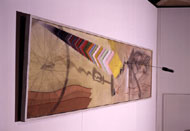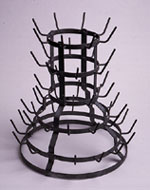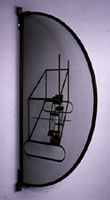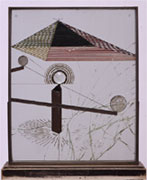|
You Do Something
To Me
| click
to enlarge |
| |
| Figure
37 |
|
Marcel
Duchamp, Tu m', 1918
|
|
Figure
38 |
|
Marcel
Duchamp, Bottle Dryer, 1914/61
|
|
|
Figure
39 |
|
Gustave
Courbet, Woman with White Stockings, 1861
|
In "Notes on
the Index", Rosalind Krauss points to the "indexical" quality
of numerous elements of Duchamp's essentially self-retrospective work,
Tu m' (1918) (Fig. 37).(61)
Krauss' indexical signs are those like the footprint in the sand which
betrays the presence of Friday to Robinson Crusoe(62)--or,
more generally, any physical or verbal trace which assumes and, therefore,
indicates the existence of its erstwhile or immediate agent. In a physical
sense, this is exactly the quality which Duchamp's erotic casts, as physical
traces, consistently both instantiate and sexualize. Verbally, as in the
case of Tu m's title, there can be no "You" if, prior
to it, there is no "Me" speaking. Or, as Sandra Bernhard so
brilliantly states the corollary, "Without You I'm Nothing".
Nevertheless, for Krauss, Tu m' is somehow indifferently indexical:
indeed, a veritable summa of verbal shifters ("You",
so "Me"), pointing hands ("Here!" which, perhaps from
my perspective, is "There!") and cast shadows (indicating the
subject of "Me and My Shadow"), albeit spoken by no one and
pointing nowhere in particular, rather too emphatically signaling the
void. Like the apparent irreducibility of its title verbal shifters--"Tu m'", which Krauss neutrally translates as "simply 'you' / 'me'"(63)--the
neutrality of its indexical signs, more generally, is only apparent. For
Tu m' is not "simply 'you' / 'me'"--there being
no "bar", nor anything else separating "us"--but rather,
given the verb its title assumes, "You are" or, more likely,
"You do" something to me. If not a Cole Porter-style
sexual provocation, Tu m' does at least imply that, rather than
standing in the disembodied no-place of entirely abstract You's and Me's,
the spectator is instead directly implicated in just the sort of "existential
relationship" on which the indexical sign is always predicated. Indeed,
standing in front of Tu m', the spectator is in the very midst
of the ur-mother of all such "existential relationships": a
vagina.
Like the unspeakably
impaled quiddity that is Duchamp's Coin de chasteté , no less
bleakly erotic is the terrible caesura which the bottlebrush rips open
in the surface of Tu m'. Yet not only is the bottlebrush by definition
insertive but also--as with the multi-phallic, even deity-like Bottlerack
(1914) (Fig. 38)--it specifically begs a
glass vessel. Thus the space the spectator occupies in front of Tu m' is not only penetrated (by the bottlebrush) but also, according to
the same logic, is itself uterine (or bottle-like) in shape. Indeed, the
space in front of Tu m', and annexed by it, is remarkably consistent,
as a virtual space (defined by the virtual presence of a glass bottle),
whose opening is likewise virtual (defined by the trompe-l'oeil breach),
yet possessed of a distinctly liminal reality: both opened by a real
bottlebrush and, in turn, closed by real safety pins. Exactly as
Duchamp describes his "bird-plus" reprise of Courbet's 1861
Woman with White Stockings (1968) (Fig. 39),
here, too, "you can see a ['faux con'] and a real one":(64)
not a falcon ["faucon"] and a fake cunt ["faux con"]
perhaps, but rather a fake cunt (a trompe-l'oeil breach, opening onto
a virtual glass bottle) and a real pecker (a real bottlebrush).(65)
For Duchamp, it
couldn't all be more logical. Rather than impute the surrounding space
of the artwork to its glass medium--exactly as we do for the Large Glass, or its freestanding Glissière (1913-15) (Fig. 40), or A regarder
(1918) (Fig. 41)--simply perform the reverse
operation: and impute the glass medium to the surrounding space of Tu
m', no differently than we need also impute the Ready-mades, whose
shadows Duchamp projects and paints onto the surface of Tu m',
to that same space.
|
click
images to enlarge
|
|
|
|
|
Figure
40 |
Figure
41 |
|
Marcel
Duchamp, Glider Containing a Water Mill in Neighboring Metals,
1913-15
|
Marcel
Duchamp, To Be Looked at (the Other Side of the Glass)
with One Eye, Close to, for Almost an Hour, 1918
|
At this level, indeed,
Duchamp's oeuvre is fairly redolent with sexualized, virtual figures:
not only the virtual glass bottle I propose, but also the optical illusions
of breasts and other part-objects engendered by his experiments with "Precision
Optics", as Krauss suggests.(66)
Dissatisfied, perhaps, that the artist's virtual glass enclosure, not
unlike the Emperor's New Clothes, can't be (dis)proved?--Duchamp surely
cackled to himself. In that case, when did you last take a good, hard
look, not through glass, but at it? Exactly as Duchamp's
title work, A regarder, instructs us: "with one eye, close
to, for almost an hour", the glass is itself "to be looked
at".(67)
Not only is the glass there, but it also has a reverse side--and
it is precisely this reverse side, "the other side of the glass"
["l'autre côté du verre"], at which we should be looking. In
addition to the three-dimensional difference of this side versus "the
other side of the glass", however, the title also alludes to the
difference of inside versus outside: again, the specifically fourth-dimensional
process of physical involution. Thus, the other side ["l'envers"]
of the glass medium ["l'en-verre"] is always-already inside-out
["à l'envers"]:(68)
"l'envers / de l'en-verre / est à l'envers". Or, as Duchamp
explains: "the reverse and the obverse acquire a circular significance...
[just as] the interior and the exterior (in the fourth dimension) can
receive a similar identification" (DDS 45; WMD 29).
In this way, the surrounding space, which Duchamp's glass artworks really
slice in three dimensions, "mirrorically returns" as the virtual
glass enclosure which Tu m' inversely assumes in four dimensions.
Nor is the complementary nature of the Large Glass (as really
slicing space) and Tu m' (as virtually enclosing it) especially
surprising insofar as both works, in the 1930s, originally complemented
and, in this sense, even completed each other in one and the same room:
Katherine Dreier's West Redding, Connecticut library.(69)
Although we can
no more see the fourth dimension than we normally do see glass, by specifically
directing our attention to "the other side of the glass",
which is always-already "inside-out", rather than ourselves
taking a walk around the glass, during an impossibly hallucinatory hour
of zero focal distance ("with one eye, close to, for almost an
hour"), in effect, the glass takes a walk around us. In the fourth
dimension, Duchamp explains, three-dimensional objects (e.g. spectators,
penises...) are felt to be "circumhyperhypo-embraced (as if grasped
with the hand and not seen with the eyes)" (DDS 126; WMD
89). If "circum-embraceability" is not itself without sexual
suggestion, Duchamp makes his sexual-as-spatial premise explicit when
he describes ideas like the fourth dimension as grasped by "the
mind the way the penis is... by the vagina".(70)
Like a specimen in a glass bottle, the spectator of Tu m' thus
becomes an object of surveillance, just as by colluding with the key-hole
of Etant Donnés, in the self-conscious process of peeping, the spectator himself
becomes the actual show.(71) >>Next
page
1 2 3
4 5 6
Notes
 60. Bettelheim, The Empty Fortress, p. 290. 60. Bettelheim, The Empty Fortress, p. 290.
 61. Krauss,
"Notes on the Index", pp. 196-99. 61. Krauss,
"Notes on the Index", pp. 196-99.
 62. Roman
Jakobson, "Quest for the Essence of Language" (1966), "Shifters
and Verbal Categories" (1957), in On language, ed. Linda Waugh,
Monique Monville-Burston (Cambridge, Mass.: Harvard University, 1990), pp. 409,
386-92. 62. Roman
Jakobson, "Quest for the Essence of Language" (1966), "Shifters
and Verbal Categories" (1957), in On language, ed. Linda Waugh,
Monique Monville-Burston (Cambridge, Mass.: Harvard University, 1990), pp. 409,
386-92.
 63. Krauss,
"Notes on the Index", p. 199. 63. Krauss,
"Notes on the Index", p. 199.
 64. Schwarz, The
Complete Works of Marcel Duchamp, p. 885. 64. Schwarz, The
Complete Works of Marcel Duchamp, p. 885.
 65.
In some sense, the Tu m' bottlebrush and "Le Pendu Femelle"
are even of a chrono(photo)graphic piece. For, just as the shadow
cast by the Tu m' bottlebrush (in the manner of a sundial,
perhaps) plots a sort of chronographic movement, the similarly
phallic "Le Pendu Femelle" is identified to chrono(photo)graphic
movement more generally. See "As Time Goes By: The Passage from
Pendu(lum) to Chronograph", herein. 65.
In some sense, the Tu m' bottlebrush and "Le Pendu Femelle"
are even of a chrono(photo)graphic piece. For, just as the shadow
cast by the Tu m' bottlebrush (in the manner of a sundial,
perhaps) plots a sort of chronographic movement, the similarly
phallic "Le Pendu Femelle" is identified to chrono(photo)graphic
movement more generally. See "As Time Goes By: The Passage from
Pendu(lum) to Chronograph", herein.
 66. Rosalind
Krauss, The Optical Unconscious (Cambridge, Mass.: M.I.T., 1993), pp.
81, 96-97, 135-37. 66. Rosalind
Krauss, The Optical Unconscious (Cambridge, Mass.: M.I.T., 1993), pp.
81, 96-97, 135-37.
 67.
The title-cum-user's manual of Duchamp's A regarder (l'autre côté
du verre) [...] is often mistranslated as To be looked at (from
[sic] the other side of the glass) [...]. 67.
The title-cum-user's manual of Duchamp's A regarder (l'autre côté
du verre) [...] is often mistranslated as To be looked at (from
[sic] the other side of the glass) [...].
 68. See
Adcock, "Duchamp's Eroticism", pp. 160-61, citing Charles Stuckey.
For Duchamp, "en verre" famously refers to how "picture on glass
['sur verre'] becomes delay in glass ['en verre'] -- but delay in glass does
not mean picture on glass... a delay in glass, as you would say a poem in prose
or a spittoon in silver" (DDS 41; WMD 26). 68. See
Adcock, "Duchamp's Eroticism", pp. 160-61, citing Charles Stuckey.
For Duchamp, "en verre" famously refers to how "picture on glass
['sur verre'] becomes delay in glass ['en verre'] -- but delay in glass does
not mean picture on glass... a delay in glass, as you would say a poem in prose
or a spittoon in silver" (DDS 41; WMD 26).
 69.
For those wondering where the left-right reversal ["l'inverse"]
always accompanying the inside-out reversal ["l'envers"]
can be found, look no farther than the Tu m' corkscrew. Ostentatiously
abetted by its pointing hand(le), the corkscrew directly signals "the
other side of the glass", where, being left-right specific, it
will immediately left-right reverse: in Tu m', as in Duchamp's
glass artworks, therefore, "l'inverse / est [au-delà de] l'envers
/ de l'en-verre". On the corkscrew's asymmetrical (i.e. left-right
reversible) helix as a venerable, fourth-dimensional trope, see Lewis
Carroll, The Annotated Alice: Alice's Adventures in Wonderland
& Through the Looking Glass, annot. Martin Gardner (N.Y.:
New American Library, 1974), pp. 180-84 (nn. 4-5). 69.
For those wondering where the left-right reversal ["l'inverse"]
always accompanying the inside-out reversal ["l'envers"]
can be found, look no farther than the Tu m' corkscrew. Ostentatiously
abetted by its pointing hand(le), the corkscrew directly signals "the
other side of the glass", where, being left-right specific, it
will immediately left-right reverse: in Tu m', as in Duchamp's
glass artworks, therefore, "l'inverse / est [au-delà de] l'envers
/ de l'en-verre". On the corkscrew's asymmetrical (i.e. left-right
reversible) helix as a venerable, fourth-dimensional trope, see Lewis
Carroll, The Annotated Alice: Alice's Adventures in Wonderland
& Through the Looking Glass, annot. Martin Gardner (N.Y.:
New American Library, 1974), pp. 180-84 (nn. 4-5).
 70.
Krauss, The Optical Unconscious, p. 111, citing Lawrence Steefel,
The Position of "La Mariée mise à nu par ses célibataires,
même" (1915-1923) in the Stylistic and Iconographic Development
of the Art of Marcel Duchamp (1960). See also DDS 131;
WMD 93, where Duchamp describes the experience of the fourth
dimension as comparable to "holding a penknife clasped in one's
fist"; Schwarz, The Complete Works of Marcel Duchamp,
p. 35 (n. 9), where Duchamp perhaps protests too much, "I would
not say that sex is the fourth dimension; far from it, I would never
say that"; rather, "Sex is three-dimensional as well as
four-dimensional". 70.
Krauss, The Optical Unconscious, p. 111, citing Lawrence Steefel,
The Position of "La Mariée mise à nu par ses célibataires,
même" (1915-1923) in the Stylistic and Iconographic Development
of the Art of Marcel Duchamp (1960). See also DDS 131;
WMD 93, where Duchamp describes the experience of the fourth
dimension as comparable to "holding a penknife clasped in one's
fist"; Schwarz, The Complete Works of Marcel Duchamp,
p. 35 (n. 9), where Duchamp perhaps protests too much, "I would
not say that sex is the fourth dimension; far from it, I would never
say that"; rather, "Sex is three-dimensional as well as
four-dimensional".
 71.
See Jones, Postmodernism and the En-gendering of Marcel Duchamp,
pp. 191-204; Judovitz, Unpacking Duchamp, pp. 199-211, where
the authors variously describe the experience of voyeurism in relation
to Etant Donnés. 71.
See Jones, Postmodernism and the En-gendering of Marcel Duchamp,
pp. 191-204; Judovitz, Unpacking Duchamp, pp. 199-211, where
the authors variously describe the experience of voyeurism in relation
to Etant Donnés.
Figs.
37-38, 40-41
©2003 Succession Marcel Duchamp, ARS, N.Y./ADAGP, Paris.
All rights reserved.
|

















